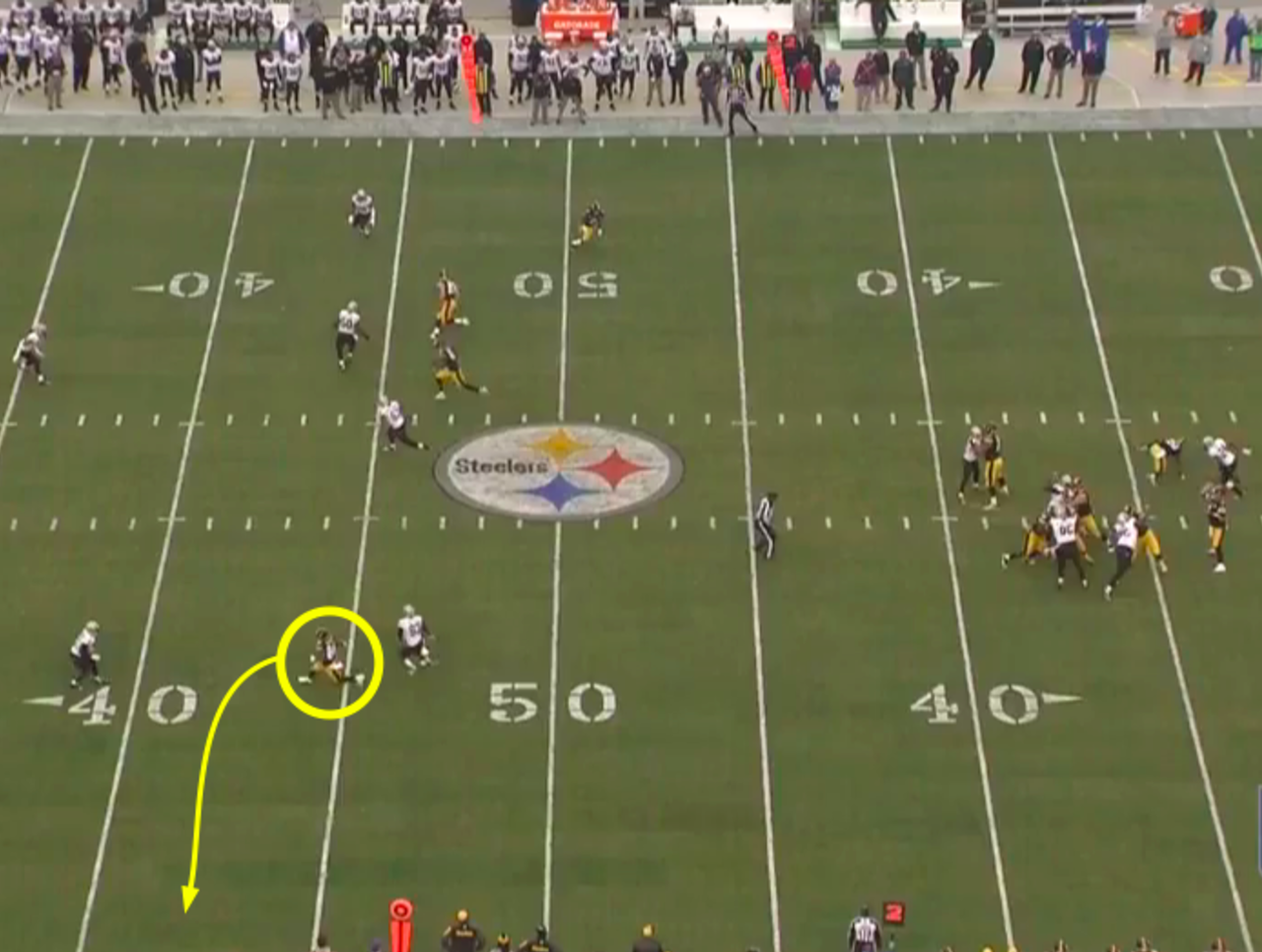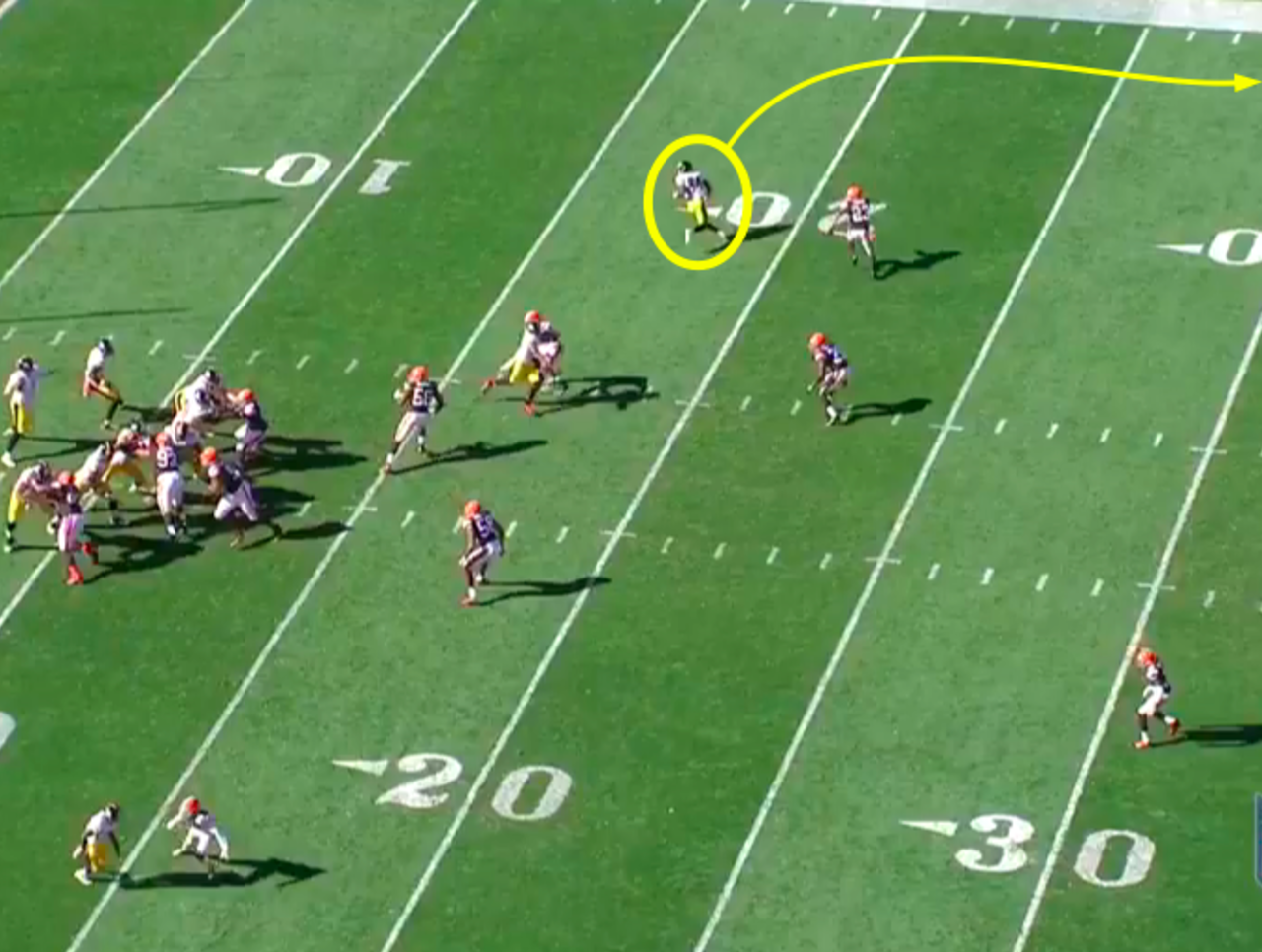Film Room: Breaking down Antonio Brown's dominant route running
Antonio Brown never quits.
He never stops working because, growing up, he was never given a choice. After every catch now at Pittsburgh Steelers practices, he turns and burns downfield. He hustles past the 20, the 10 and all the way to the end zone.
This season, Brown has caught 17 passes of 20 yards or more, eighth-most. He's put himself in position to make big plays after the catch by setting up defensive backs and separating from them. He bursts on post routes, accelerates on divide routes and jukes on post-corner routes. Though, none are as sublime as his perfected out route.
An out route comes in two forms: quick or deep. The quick out is usually five yards up and out to the sideline.The deep out breaks after 12 to 15 yards to the sideline. That’s where Brown leaps, extends his arms to catch the football and drops to his feet to drag them inbounds as he falls out of bounds. That’s the easiest part. The hardest part: identifying a cornerback’s leverage and then misleading him.
On one play in Week 13, Brown was aligned outside the numbers. Across from him, a New Orleans Saints cornerback stood with a cushion. The cornerback was aligned slightly outside in Cover 2, which required that he not get beat vertically down the sideline or middle of the field. Brown released with a diagonal stem to push the cornerback toward the middle of the field, toward the inside of the numbers.

The cornerback backpedaled as he watched Brown’s route unfold. Then he weaved inside. He backpedaled more downfield with his shoulders square, disciplined, as he watched Brown run diagonally.
In front of Brown, the cornerback covered over the top and, to Brown’s right, an outside linebacker walled off the inside. He was essentially double teamed. For him to create separation, he would have to sell the route tremendously and then break outside quickly.

In front of the cornerback, Brown straightened up his stem, squared up his shoulders and ate up the cushion. He pressed the cornerback onto his heels as if he was running a go-route, then he jabbed his right foot inside after 15 yards. He fled outside and flattened his deep out route as the cornerback trailed. Down by the sideline, Brown tapped both feet inbounds for a 21-yard catch.
Before Brown made big catches for the Steelers, he made them for the Central Michigan Chippewas. The Chippewas saw a homeless kid with something to prove, natural talent and a work ethic, and offered him a scholarship after he arrived as a walk-on. They moved him from his high school position of quarterback to wide receiver, where he flourished.
Over the course of three seasons, he snatched 305 passes and scored 22 touchdowns. He torched secondaries with an uncommon blend of quickness and physicality at 5-foot-10 and 186 pounds. In his junior season, he caught college-highs of 110 passes, nine touchdowns and nearly 1,200 yards. Then he declared for the 2010 NFL Draft and the Steelers selected him in the sixth round.
He’s been their playmaker ever since.
Against the Cleveland Browns in Week 6, Brown reduced his split to the inside. A cornerback was lined up in off coverage with a cushion. He was responsible for a quarter of the field, in quarter-quarter-half coverage, and was lined up well inside the numbers.

Brown stemmed diagonally off the line, rounded outside. The cornerback stood flat-footed, read a three-step throw and ran to Brown’s inside hip. Brown looked back as if he was expecting a throw. The cornerback attacked faster, tighter to the inside hip.

Then Brown snapped his head downfield. Suddenly it wasn’t a quick out; it was a quick out-and-up. He looped around the cornerback and ran down the sideline, where he tapped his left foot and then his right for a 23-yard catch.
In 2014, Brown has outworked other receivers to the tune of 105 receptions, a dozen more than the second-most. He has been targeted a dozen more times than the second-best receiver, too. He has caught at least five passes for 74 yards or more in every game. Also, Brown has outworked cornerbacks for 434 yards after the catch, third-most among receivers.
In Week 9 against the hated Baltimore Ravens, Brown was in a wide split outside the numbers while a cornerback was tight to the line. The cornerback stood in front of him and showed man coverage. There were two deep safeties. Bracket coverage was expected, with the cornerback trailing underneath and the safety rolling over the top.

To beat coverage, Brown had to first unseat the cornerback. He stepped left and dipped his shoulder. That opened the cornerback’s hips to the inside, leaving a straight-ahead path outside the numbers.

As Brown sprinted downfield, he leaned in across the numbers and the cornerback followed him. The diagonal stem created more room outside. At the same time, it pushed the safety further back. The cornerback fell behind and Brown stabbed through the grass with his left foot after 13 yards and cut outside, leaped up and spun to trap the ball.
Once he caught it, he took off again inside for 54 yards. He stiff-armed the near safety, blew past the nickel cornerback, crossed the near hash, broke a tackle from another cornerback, crossed the far hash, past the 20, the 10 and all the way to the end zone.
HEADLINES
- Brady offers advice to Mahomes after ACL tear: 'One of the toughest rehabs'
- Notre Dame's Love declares for 2026 NFL Draft
- NFL Power Rankings - Week 16: Every team's unsung hero
- Fantasy: Must-add targets who can help carry you to a championship
- Packers' Jacobs says he aggravated knee injury in loss to Broncos